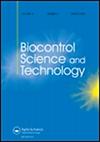爱尔兰拉加虹吸寄主范围生物防治的风险评估
IF 1.2
4区 农林科学
Q4 BIOTECHNOLOGY & APPLIED MICROBIOLOGY
引用次数: 0
摘要
Lagarosiphon major (Ridl.)苔藓(Hydrocharitaceae)是一种原产于南非的水下淡水植物,是欧洲、澳大拉西亚和美国水道的破坏性入侵植物。本土范围的勘探发现了一种采叶蚜蝇,hydrorellia lagarosiphon,是一种有前途的生物防治候选剂。采用实验室无选择试验和配对选择试验对拉格罗辛吸虫进行宿主特异性研究。在非选择和配对选择实验中,许多非目标土生马铃薯持续遭受取食损害。为了防止对一种可能安全的药物产生排斥反应,我们选择了一些土豆科植物进行了多代种群持久性试验。非目标种不能维持一个有活力的拉格罗西丰种群超过两代。综合偏好和相对存活率的风险评估表明,3种非目标种相对于L. major的持续损害风险极低(<1.3%)。多角扁豆(Potamogeton polygonifolius)和平针叶扁豆(p.x lanceolatus)的繁殖风险分别为5.61%和11.5%,但不能支持超过2代的存活种群。这些结果,再加上伤害效果和预测的定殖,证明了拉格罗斯虹吸作为爱尔兰大蠊的生物防治剂的潜力。传统的生物防治方法是一种安全、经济有效的控制入侵性沉水杂草的方法。多代种群持久性测试加强了宿主特异性测试,以预测生物防治剂的喂养和繁殖风险。风险评估数据显示,低水平的拉格罗辛水螅幼虫摄食可能发生在3种非目标品种上。虽然两种本地的波塔莫吉顿蝇的繁殖风险相对较低,但它们没能让这种苍蝇存活到第二代以后。传统的生物防治为昂贵的机械或不适合环境的化学防治提供了一种替代的防治策略,因为在本预释放测试程序中已经确定了拉格罗辛水螅的安全性。这里提出的风险评估可以构成向监管当局申请在爱尔兰的L. major上释放H. lagarosiphon的基础。本文章由计算机程序翻译,如有差异,请以英文原文为准。
Risk assessment of the host range of Hydrellia lagarosiphon for the biological control of Lagarosiphon major in Ireland
ABSTRACT Lagarosiphon major (Ridl.) Moss ex Wager (Hydrocharitaceae) is a submerged freshwater plant native to South Africa, and a destructive invader of waterways across Europe, Australasia and the U.S.A. Native range exploration identified a leaf mining ephydrid fly, Hydrellia lagarosiphon, as a promising biological control candidate agent. Host specificity was conducted on H. lagarosiphon, using laboratory no-choice and paired choice tests. A number of non-target native Potamogeton species sustained feeding damage under no-choice and paired choice testing. To prevent rejection of a potentially safe agent, multi-generational population persistence trials were conducted on select native Potamogetonaceae. The non-target species could not sustain a viable H. lagarosiphon population beyond two generations. A risk assessment, incorporating the preference and relative survival, indicated that three non-target species presented extremely low (<1.3%) risk of sustaining damage relative to that of L. major. Potamogeton polygonifolius and P. x lanceolatus present a reproductive risk of 5.61% and 11.5% respectively but could not support a viable population beyond the 2nd generation. These results, coupled with damage efficacy and predicted colonisation, demonstrate the potential H. lagarosiphon has as a biological control agent for L. major in Ireland. Highlights Classical biological control could provide a safe, cost-effective method of control of the invasive submerged weed Lagarosiphon major. Multigenerational population persistence tests strengthen host specificity testing to predict feeding and reproductive risks of a biological control agent. Risk assessment data suggest a low level of Hydrellia lagarosiphon larval feeding could occur on three non-target Potamogeton species. While two native Potamogeton species sustain a relatively low reproductive risk, they failed to sustain the fly beyond the 2nd generation. Classical biological control provides an alternative control strategy to costly mechanical or environmentally unsuitable chemical control as the safety of Hydrellia lagarosiphon has been established in this pre-release testing procedure. The risk assessment presented here could form the basis of an application to the regulatory authorities to release H. lagarosiphon on L. major in Ireland.
求助全文
通过发布文献求助,成功后即可免费获取论文全文。
去求助
来源期刊
CiteScore
3.20
自引率
7.10%
发文量
64
审稿时长
4-8 weeks
期刊介绍:
Biocontrol Science and Technology presents original research and reviews in the fields of biological pest, disease and weed control. The journal covers the following areas:
Animal pest control by natural enemies
Biocontrol of plant diseases
Weed biocontrol
''Classical'' biocontrol
Augmentative releases of natural enemies
Quality control of beneficial organisms
Microbial pesticides
Properties of biocontrol agents, modes of actions and methods of application
Physiology and behaviour of biocontrol agents and their interaction with hosts
Pest and natural enemy dynamics, and simulation modelling
Genetic improvement of natural enemies including genetic manipulation
Natural enemy production, formulation, distribution and release methods
Environmental impact studies
Releases of selected and/or genetically manipulated organisms
Safety testing
The role of biocontrol methods in integrated crop protection
Conservation and enhancement of natural enemy populations
Effects of pesticides on biocontrol organisms
Biocontrol legislation and policy, registration and commercialization.

 求助内容:
求助内容: 应助结果提醒方式:
应助结果提醒方式:


